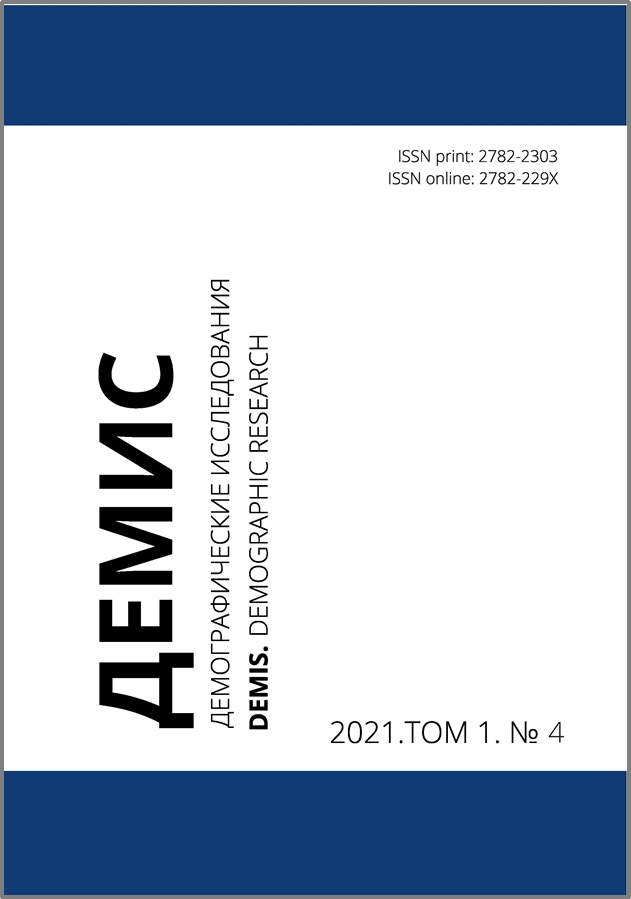Международная миграция старшего поколения: общемировые и российские тенденции
Научная статья
Аннотация
Литература
2. Карачурина Л. Б., Иванова К. А. Миграция пожилых в России (по данным переписи населения 2010 г.) // Региональные исследования народонаселения. 2017. №3 (57). С. 51–60.
3. Гридасов Г. Н., Захарова Н. О., Балуева Е. С. Сравнительный анализ динамики миграционного прироста пожилого населения Самарской области // Успехи геронтологии. 2011. Т. 24. № 4. С. 707–712.
4. Ефремов И. А. Возрастные особенности миграционных процессов на Крайнем Севере России // Демоскоп Weekly. 2014. № 581–582. С. 54–62.
5. Мкртчян Н. В. Возрастная структура населения России и ее влияние на внутреннюю миграцию // Научные труды: Институт народнохозяйственного прогнозирования РАН. 2015. Т. 13. С. 209–221.
6. Greenwood M. J. Migration and Labor Market Opportunities / M. M. Fischer, P. Nijkamp (Eds.), Handbook of Regional Science. Berlin: Springer, 2013. Pp. 3–16. DOI: https://doi.org/10.1007/978-3-642-23430-9_5.
7. Litwak E., Longino C. F. Migration Patterns Among the Elderly: A Developmental Perspective. The Gerontologist. 1987. Vol. 27. No. 3. Pp. 266–272. DOI: https://doi.org/10.1093/geront/27.3.266.
8. Serow W. J. Demographic and Socioeconomic Aspects of Elderly Migration in the 1980s. Journal of Aging & Social Policy. 1996. Vol. 8. No. 1. Pp. 19–38. DOI: https://doi.org/10.1300/j031v08n01_04.
9. Baldassar L., Baldock C. V., Wilding R. Families Caring Across Borders: Migration, Ageing and Transnational Caregiving. London: Palgrave Macmillan, 2007. 259 p. DOI: https://doi.org/10.1057/9780230626263.
10. Zechner M. Care of older persons in transnational settings. Journal of Aging Studies. 2008. Vol. 22. No. 1. Pp. 32–44. DOI: https://doi.org/10.1016/j.jaging.2007.02.002.
11. Wilding R., Baldassar L. Ageing, migration and new media: The significance of transnational care. Journal of Sociology. 2018. Vol. 54. No. 2. Pp. 226–235. URL: https://doi.org/10.1177/1440783318766168.
12. Baldassar L., Wilding R. Migration, Aging, and Digital Kinning: The Role of Distant Care Support Networks in Experiences of Aging Well. The Gerontologist. 2019. Vol. 60. No. 2. Pp. 313–321. DOI: https://doi.org/10.1093/geront/gnz156.
13. Klok J., van Tilburg T. G., Suanet B., Fokkema T., Huisman M. National and transnational belonging among Turkish and Moroccan older migrants in the Netherlands: protective against loneliness? European Journal of Ageing. 2017. Vol. 14. No. 4. Pp. 341–351. DOI: https://doi.org/10.1007/s10433-017-0420-9.
14. Snel E., Burgers J., Leerkes A. Class Position of Immigrant Workers in a Post-Industrial Economy: The Dutch Case. Journal of Ethnic and Migration Studies. 2007. Vol. 33. No. 8. Pp. 1323–1342. DOI: https://doi.org/10.1080/13691830701614106.
15. Klokgieters S. S., van Tilburg T. G., Deeg D. J. H., Huisman M. The Linkage Between Aging, Migration, and Resilience: Resilience in the Life of Older Turkish and Moroccan Immigrants. The Journals of Gerontology: Series B. 2019. Vol. 75. No. 5. Pp. 1113–1123. DOI: https://doi.org/10.1093/geronb/gbz024.
16. Garcia M. A., Reyes A. M., Downer B., Saenz J. L., Samper-Ternent R. A., Raji M. Age of Migration and the Incidence of Cognitive Impairment: A Cohort Study of Elder Mexican-Americans. Innovation in Aging. 2017. Vol. 1. No. 3. Pp. 1–11. DOI: https://doi.org/10.1093/geroni/igx037.
17. Holecki T., Rogalska A., Sobczyk K., Woźniak-Holecka J., Romaniuk P. Global Elderly Migrations and Their Impact on Health Care Systems. Frontiers in Public Health. 2020. Vol. 8. Pp. 1–6. DOI: https://doi.org/10.3389/fpubh.2020.00386.
18. Zaiceva A. The impact of aging on the scale of migration. IZA World of Labor. 2014. Vol. 99. 1 p. DOI: https://doi.org/10.15185/izawol.99.
19. Pennington J. Moving on: Migration trends in later life. London: Institute for Public Policy Research, 2013. 22 p.
20. Pannell J., Aldridge H., Kenway P. Market assessment of housing options for older people: A report for Shelter and the Joseph Rowntree Foundation. London: New Policy Institute, 2012. 90 p.
21. World Bank; International Monetary Fund. Global Monitoring Report 2015/2016: Development Goals in an Era of Demographic Change. Washington, DC: World Bank, 2016. 283 p. DOI: https://doi.org/10.1596/978-1-4648-0669-8.
22. Плоских Е. В., Кудайкулова Ш. Х. Особенности классической теории демографического перехода // Вестник кыргызско-российского славянского университета. 2014. Т. 14. № 6. С. 104–108.
23. Римашевская Н. М., Доброхлеб В. Г., Медведева Е. И., Крошилин С. В. Демографический переход – специфика российской модели // Народонаселение. 2012. №1 (55). С. 23–31.
24. Laslett P. The Third Age, The Fourth Age and The Future. Ageing and Society. 1994. Vol. 14. No. 3. Pp. 436–447. DOI: https://doi.org/10.1017/s0144686x00001677.
25. Chevan A. Holding On and Letting Go: Residential Mobility During Widowhood. Research on Aging. 1995. Vol. 17. No. 3. Pp. 278–302. DOI: https://doi.org/10.1177/0164027595173003.
26. Milewski N., Loth A. Residential Mobility in the Second Half of Life: The Role of Family-Related Transitions and Retirement / Aybek C., Huinink J., Muttarak R. (eds.) Spatial Mobility, Migration, and Living Arrangements. Berlin: Springer, 2015. Pp. 225–246. DOI: https://doi.org/10.1007/978-3-319-10021-0_11.
27. Nielsen S. S., Krasnik A. Poorer self-perceived health among migrants and ethnic minorities versus the majority population in Europe: a systematic review. International Journal of Public Health. 2010. Vol. 55. No. 5. Pp. 357–371. DOI: https://doi.org/10.1007/s00038-010-0145-4.
28. Гневашева В. А. Современные особенности рынка труда: предпосылки государственного регулирования // Экономика: вчера, сегодня, завтра. 2020. Т. 10. № 6–1. С. 139–149. DOI: https://doi.org/10.34670/AR.2020.71.57.017.
29. Рязанцев С. В. Новая депопуляция в России: новые вызовы и пути нейтрализации // Человек и его ценности в современном мире: материалы XI Международной научно-практической конференции, Чита, 23–28 сентября 2019 г. / Забайкальский гос. ун-т; [отв. ред. Эрдынеева К. Г.]. – Чита: ЗабГУ, 2019. С. 8–16.
30. Kaneda T., Lee M., Pollard K. SCL/PRB Index of Well-Being in Older Populations: Final Report. Global Aging and Monitoring Project. Washington: Population Reference Bureau, 2011. 57 p.
31. Концепция политики активного долголетия: научно-методологический докл. к XXI Апр. междунар. науч. конф. по проблемам развития экономики и общества, Москва, 2020 г. / под ред. Л. Н. Овчаровой, М. А. Морозовой, О. В. Синявской; Нац. исслед. ун-т «Высшая школа экономики». – М.: Изд. дом Высшей школы экономики, 2020. – 40 с. DOI: https://doi.org/10.17323/978-5-7598-2173-1.
Поступила: 30.07.2021
Опубликована: 06.12.2021






